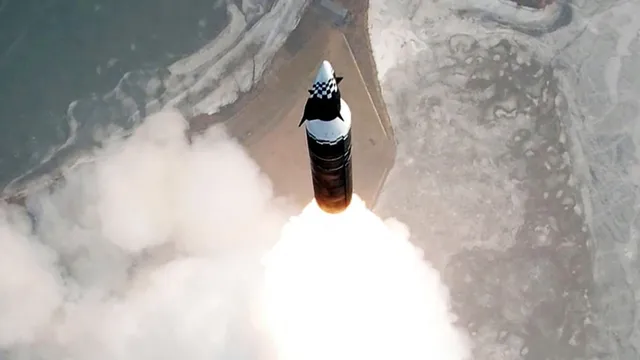
North Korea tests new hypersonic missile capable of hitting distant Pacific targets
2025-01-08 01:21- North Korea conducted a missile test on January 7, 2025, revealing advancements in hypersonic technology.
- The missile reportedly flew 1,100 kilometers before landing in waters between the Korean Peninsula and Japan.
- Kim Jong Un's push for a larger nuclear arsenal highlights ongoing tensions in East Asia and escalates security concerns.
Express your sentiment!
Insights
In a significant development related to military capabilities, North Korea conducted a missile test on January 7, 2025, demonstrating its advancements in hypersonic technology. This test involved an intermediate-range missile that reportedly flew 1,100 kilometers (685 miles) before landing in waters between the Korean Peninsula and Japan. North Korean state media reported that the test was supervised by Kim Jong Un, who pledged to expand the nation's collection of nuclear-capable weapons to counter perceived threats from rival nations in the region. The launch occurred amidst heightened tensions in East Asia and just weeks before Donald Trump was to return to the US presidency. The missile test follows a year of heightened military activity by North Korea, marked by multiple weapons system demonstrations that targeted neighboring countries and the United States. Concerns were raised regarding North Korea’s collaboration with Russia, especially in light of technology transfers due to the geopolitical alignment over the ongoing war in Ukraine. The application of solid-fuel intercontinental ballistic missiles and hypersonic warheads has raised alarms about the North’s potential to escalate its military capabilities and pose greater threats to regional security. In its efforts to develop hypersonic weapons capable of flying at over five times the speed of sound, North Korea has increasingly tested missile systems which can evade existing missile defense strategies. The news agency reported that the recent test achieved unprecedented speeds, claiming the missile traveled 12 times the speed of sound, although South Korean military experts have expressed skepticism regarding these claims, suggesting that the actual distance covered was shorter. These developments come as US Secretary of State Antony Blinken visited Seoul to discuss North Korea's nuclear threat. During the visit, Blinken condemned North Korea’s missile launches as violations of UN Security Council resolutions, reaffirming the commitment of the US and its allies to address the growing North Korean arsenal. Experts view this launch as a continuation of Kim Jung Un's strategy to solidify and expand his nuclear weapons program in the face of international scrutiny and pressure from the United States and consorting nations in the region.
Contexts
The United States has maintained a vigilant stance in response to North Korea's missile tests, which have escalated tensions in the region and posed significant challenges to international security. As North Korea continues to develop its missile capabilities, including intercontinental ballistic missiles (ICBMs) and various short-range and medium-range systems, the U.S. has been coordinating closely with its allies, particularly South Korea and Japan, to devise effective strategies aimed at deterrence. The comprehensive approach encompasses diplomacy, economic sanctions, and military readiness to address the evolving threats posed by North Korean missile activities, which are characterized by regular tests and advancements in technology designed to enhance the range and precision of their arsenal. The U.S. government has consistently condemned these missile tests as violations of United Nations Security Council resolutions that prohibit such activities. Following each test, the U.S. has sought to rally international condemnation against North Korea, emphasizing the need for a united front to deter further provocations. Diplomatic efforts have included participation in multilateral forums aimed at dialogue and de-escalation, though these have often faced setbacks due to North Korea's insistence on maintaining its missile program and its refusal to abandon its nuclear ambitions. The Biden administration, like its predecessors, has underscored the importance of denuclearization as a key objective while expressing a willingness to engage in negotiations under the right conditions. In addition to diplomatic measures, the U.S. has implemented a range of economic sanctions targeting North Korea's missile program and its overall economy. These sanctions are designed to limit the regime's access to materials and technology necessary for missile development, thereby impeding further advancements. Although these sanctions have exerted pressure on the North Korean economy, their effectiveness has been moderated by the regime's ability to procure resources through illicit channels. As a result, the interplay between sanctions and North Korea's missile capabilities remains complex, highlighting the need for a more integrated and strategic approach that combines pressure with engagement. Military readiness continues to be a cornerstone of the U.S. response, which includes the deployment of advanced missile defense systems in the region, such as THAAD (Terminal High Altitude Area Defense) and Aegis-equipped naval vessels. These systems serve as a deterrent against potential North Korean missile threats and enhance the defense capabilities of U.S. allies in East Asia. The U.S. commitment to defending its allies in the face of North Korean aggression remains steadfast, and such military posturing is critical to ensuring regional stability. Nonetheless, the overarching challenge lies in navigating the highly volatile landscape of U.S.-North Korea relations, where diplomatic strategies must adapt to the realities of an evolving security environment characterized by North Korea's persistent missile testing activities.